Scottish household survey 2019: key findings
An infographic summary of the key findings from the 2019 edition of the Scottish Household Survey, a continuous survey running since 1999 based on a sample of the general population in private residences in Scotland.
Section Eight - Physical Activity and Sport
8 in 10 adults in Scotland participated in physical activity in Scotland in the previous four weeks.
Between 2007 and 2017, there was an increase in the proportion of people participating in physical activities, which was largely due to an increase in recreational walking.
However, since 2017 overall participation decreased slightly from 81% to 80% of the population. This shift was due to a slight decrease in the participation in recreational walking.
There had also been a decrease in the proportion of adults who did not participate in any sports or physical activities, from 27% in 2007/2008 to 20% in 2019.
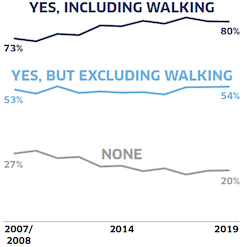
This line graph shows participation in physical activities in sports in the previous four weeks, and how this changed between 2007 and 2019. It shows the proportion of adults participating in any physical activities and sports including walking, the proportion of adults participating in physical activities excluding walking, and the proportion of adults not participating in any physical activities or sports. It highlights that participating in a physical activity including walking was has increased over time, and as well as that the proportion of adults not participating in any activities has decreased.
Active people were becoming more active:
In 2019, 51% of people participated in physical activity or sport on more than 14 days of the last 28 days, up from 36 percent in 2007
This data was not collected before 2007.
Adults with higher educational qualifications were significantly more likely to participate in physical activities.
The proportion of adults who participated in physical activities increased among those with a HNC/HND, a degree or a professional qualification, from 85% in 2007/2008 to 90% in 2019.
Likewise, the proportion of those whose highest educational qualification was a standard grade or higher who participated in physical activities had increased from 79% in 2007/2008 to 81% in 2019.
However, among adults who had no qualifications, the proportion who took part in physical activities was consistent throughout this time period.
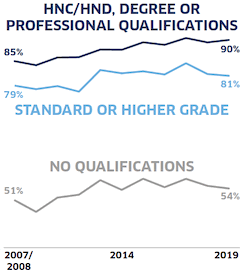
This line graph shows participation in physical activities (including walking) between 2007 and 2019, broken down by educational qualification. These qualifications are “HNC/HND, Degree or Professional Qualifications”, “Standard or Higher Grade”, and “No Qualifications”. It highlights that a higher proportion of adults with a higher educational level participated in physical activities and sports.
More men than women participated in physical activities in the past month in 2019.
78% of women and 82% of men took part in a physical activity over the previous month, including walking.
The proportion of both men and women who participated in physical activities had increased since 2007/2008.
However, the proportion of women taking part in physical activities increased more, slightly closing the gap between the two groups from 6 percentage point in 2007/2008 to 4 percentage points in 2019.
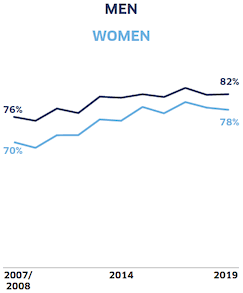
This line graph shows participation in physical activities and sports between 2007 and 2019, broken down by gender. It highlights that while participation in physical activities was increasing for both genders, a larger proportion of men consistently took part in physical activities.
Walking was the most common form of physical activity for both men and women
After walking, Keep Fit classes (17%) and swimming (19%) were the most common activities for women, while weight training was the second most common for men (19%)
The sample size of those who identified in another way is too small for robust analysis.
Levels of participation in physical activities other than walking was significantly different in different age groups.
Adults between 16 and 34 were the most likely to participate in physical activities, with 72% doing recreational walking and 67% participating in other sports. Among those over 60, 58% did recreational walking and 36% participated in other sports.
The proportion of adults doing recreational walking had increased since 2007 among all age groups, and among older people there was also an increasing proportion doing other sports.
The proportion of younger adults doing other sports had decreased significantly after a peak in 2011, from 72% to 67% in 2019. In this age group, 10% of adults between 16 and 34 did not take part in any physical activities.
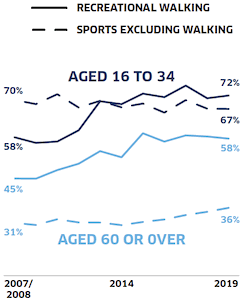
This line graph shows participation in physical activities and sports between 2007 and 2019, broken down by age groups. Specifically, it shows the proportion of adults aged 16 to 34 and aged 60 or over, participating in recreational walking or in sports excluding recreational walking. It highlights that younger adults were more likely to take part in both forms of physical activity, and that for both groups, recreational walking was more common than doing other forms of physical activities.
There was no significant difference in participation in physcial activities between men and women aged 16 to 24 when including walking
However, men in this age group were more likely to participate in other sports than women, and women were significantly more likely to do recreational walking
There was a significant difference in levels of participation in physical activities between the most and least deprived areas in Scotland.
The proportion of adults participating in physical activities had increased in the 20% least deprived areas in Scotland, both when regarding walking and other sports.
While the proportion of adults doing recreational walking had increased in the 20% most deprived areas, it was still significantly lower than in the least deprived areas.
The proportion of adults participating in other sports in the most deprived areas had not increased, as opposed to in that of the least deprived areas.
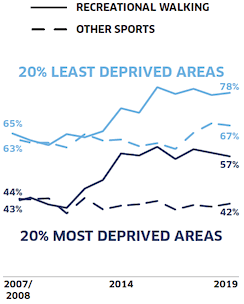
Dancing, football, golf and snooker, billiards or pool
This line graph shows participation in physical activities and sports between 2007 and 2019, broken down by age groups. Specifically, it shows the proportion of adults aged 16 to 34 and aged 60 or over, participating in recreational walking or in sports excluding recreational walking. It highlights that younger adults were more likely to take part in both forms of physical activity, and that for both groups, recreational walking was more common than doing other forms of physical activities.
3 in 10 adults in the 20% most deprived areas in Scotland did not take part in any physical activities
Walking was the most common physical activity in Scotland, and was the activity that had increased the most in popularity in the past decade.
Many activities were popular in both the most and least deprived areas. However, trends in some activities were different between areas.
In the most deprived areas, the only sport that had significantly increased in popularity since 2013 was cycling.
In the least deprived areas, the sports that had increased in popularity since 2013 were walking and weight training.
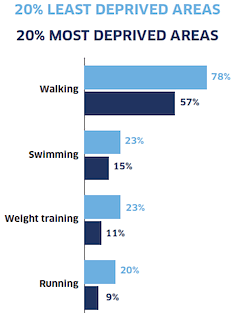
This bar chart lists the most common types of physical activities, showing the proportion of adults taking part in them in the most and least deprived areas in Scotland. Starting with the most common, it lists “Walking”, “Swimming”, “Weight training”, and “Running”. It highlights that trends in the types of activities differed between areas, and many of these activities were more popular in the least deprived areas.
Dancing, football, golf and snooker, billiards or pool
were the physical activities that had decreased in popularity the most since 2007
Contact
Email: shs@gov.scot
There is a problem
Thanks for your feedback